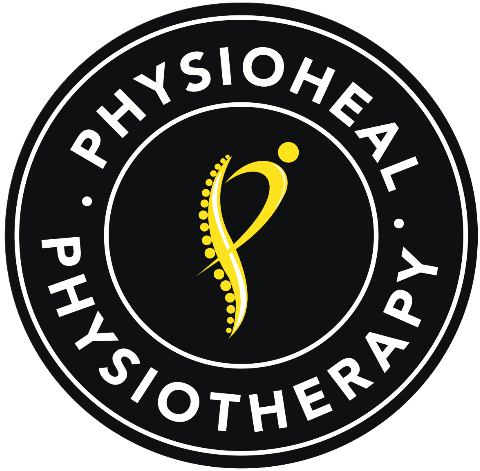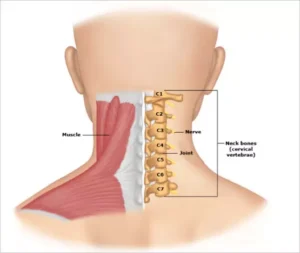We Are Open For Cervical Spondylosis Treatment in Gurgaon!
Fill the form and let us call you back.
[gravityform id="3" title="false" description="false"]
Cervical Spondylosis Treatment at Physioheal Physiotherapy, Gurgaon
Cervical spondylosis
Cervical spondylosis, a condition stemming from wear and tear of the neck’s vertebrae and intervertebral discs, holds significant importance in understanding neck health. As we age, the discs in our neck undergo thinning, leading to degenerative changes that can result in discomfort and disability. This page delves into the intricate details of cervical spondylosis, including its symptoms, causes, diagnosis, treatment options, and the pivotal role that physiotherapy plays in managing this condition.
 Symptoms of Cervical Spondylosis: Navigating Discomfort and Flare-Ups
Symptoms of Cervical Spondylosis: Navigating Discomfort and Flare-Ups
Individuals grappling with cervical spondylosis often experience a spectrum of symptoms, ranging from mild to severe:
- Flare-ups of symptoms occur periodically.
- Common symptoms encompass neck pain and stiffness.
- Potential pain radiation to regions like the occiput, between the shoulder blades, and upper limbs.
- Retro-orbital or temporal pain.
- Vague sensations of numbness, tingling, or weakness in the upper limbs.
- Occasional dizziness, vertigo, or balance issues.
Causes of Cervical Spondylosis: Unraveling Wear and Tear
Cervical spondylosis originates from age-related degeneration. Factors contributing to its development include:
- Thinning of intervertebral discs and vertebrae changes.
- Roughening of vertebrae edges.
- Surrounding muscle, ligament, and nerve irritation due to structural alterations.
Diagnosing Cervical Spondylosis: Identifying the Culprit
Diagnosing cervical spondylosis relies on clinical evaluation and assessment of signs and symptoms:
- Clinical Signs:
- Vague tenderness in the affected area.
- Limited neck mobility.
- Minor neurological alterations (unless complicated by myelopathy or radiculopathy).
- Symptoms:
- Neck pain exacerbated by movement.
- Referred pain to various regions, including the occiput, between the shoulder blades, and upper limbs.
- Discomfort patterns like retro-orbital or temporal pain.
- Cervical stiffness.
- Occasional numbness, tingling, or weakness in the upper limbs.
- Episodes of dizziness, vertigo, or imbalance.
- Rare instances of syncope or migraine triggers.
- Diagnostic imaging such as X-ray, CT, MRI, and EMG might be employed to confirm the diagnosis if deemed necessary.
Treatment Strategies for Cervical Spondylosis: Navigating Recovery
Physiotherapy is very important in the treatment of cervical spondylosis. Initially your physiotherapist can assess you and diagnose your problem. Following the initial assessment your physiotherapist will write a treatment plan specifically for you. Physiotherapy treatment for cervical spondylosis often comprises of a home exercise programme to increase the range of movement and muscle control of your neck. Other physiotherapy treatments may include:
- Manual therapy : Manual therapy of the thoracic spine can be used for reduction of pain, improving function, to increase the range of motion and to address the thoracic hypomobility.
- Thrust manipulation of the thoracic spine could include techniques in a prone, supine, or sitting position based on therapist preference. Also cervical traction can be used as physical therapy to enlarge the neural foramen and reduce the neck stress.
- Non-thrust manipulation included posterior-anterior (PA) glides in the prone position. The cervical spine techniques could include retractions, rotations, lateral glides in the ULTT1 position, and PA glides. The techniques are chosen based on patient response and centralisation or reduction of symptoms.
- Postural education includes the alignment of the spine during sitting and standing activities.
- Thermal therapy provides symptomatic relief only and ultrasound appears to be ineffective.
- Soft tissue mobilisation was performed on the muscles of the upper quarter with the involved upper extremity positioned in abduction and external rotation to pre-load the neural structures of the upper limb.
- Home Exercises include cervical retraction, cervical extension, deep cervical flexor strengthening, scapular strengthening, stretching of the chest muscles via isometric contraction of flexor of extensor muscles to encourage the mobility of the neural structures of the upper extremity.
- Education. The natural history of cervical spondylosis is highly variable, as well as challenging to prevent, given that it is part of the normal aging process. The client should receive training on ways to deter early onset of cervical spondylosis, including maintaining good neck strength and flexibility, leading an active and healthy lifestyle, and preventing neck injuries (e.g., good ergonomics, avoiding prolonged neck extension, proper equipment for contact sports, safe tackling technique, and seatbelt use in automobiles).
Trust in Physioheal Physiotherapy Gurgaon for Optimal Care
For comprehensive care and effective treatment of cervical spondylosis, turn to Dr. Divya Gaur at Physioheal Physiotherapy Clinic Gurgaon. Our seasoned physiotherapists are dedicated to your well-being, ensuring a smooth rehabilitation journey. To schedule an appointment, call +91-9999259307, book online, or request a phone consultation.

 Symptoms of Cervical Spondylosis: Navigating Discomfort and Flare-Ups
Symptoms of Cervical Spondylosis: Navigating Discomfort and Flare-Ups